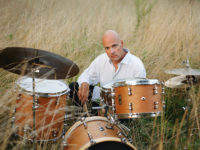April 6th of last year was assuredly a special night for Andrea Centazzo. He was leading a thirteen-piece orchestra through five of his compositions at NYC’s The Stone club, during a fifteen-day festival celebrating the 30th anniversary of the storied creative music label he co-founded, Ictus Records. The label, reborn six years earlier after a lengthy haitus, had just last month issued a souvenir of that event, entitled The Battle.
You might not have heard of Andrea Centazzo, but he is a fascinating figure in music. Called by Allmusic.com as “Italy’s top orchestral percussionist,” he also holds a doctorate degree in Musicology and has written eight books on the subject. He’s also authored more than 350 compositions, had performed with John Zorn, Derek Bailey, Steve Lacy, and Don Cherry and was an early architect of audio/video media, combining live performance with video images since the early 80’s. Such work has led to numerous awards in cinema as well as music. You know that electro-acoustic and sampling craze that’s become all the rage within progressive jazz circles the last few years? Centazzo’s been doing that for decades, now. And lastly, Centazzo co-founded Ictus Records in 1976 along with Carla Lugli, an Italian based label that issued albums by Centazzo and his collaborations with Lacy, Bailey, Zorn, Eugene Chadbourne, Tom Cora, the Rova Saxophone Quartet, Lol Coxhill, and several others.
With all the recordings (60+) and concerts (over 1,000), Centazzo hadn’t indulged in the jazz orchestral setting, at least on record, since his Andrea Centazzo Mitteleuropa Orchestra from thirty years ago. The Battle marks a return to the large form in a large way. The Invasion Orchestra was an ensemble composed of Centazzo handling percussion and conduction, along with a drummer, three trumpet players, a trombonist, two bass players (one acoustic, one electric), three sax/clarinet players, a pianist, and a guy to help the drummer handle electronic effects.
Centazzo doesn’t utilize a big band the way most composers and conductors do. They usually endeavor to use the large band to make a large, heavily layered noise. Centazzo exploits the opportunity of having a dozen improvisers at his disposal, and it’s his ingenious interspersing of scored music with wide-open improvisational passages that sets him apart.
Everyone in the band gets a spotlight and often, improvisers are paired up or even tripled up and sometimes soloists start out solo but are eventually joined by others. Thus, Carlo Actis Dato’s tart baritone sax solo is joined by his saxophone brethren, Achille Succi (alto saxophone) and Roberto Ottaviano (soprano saxophone) on “The Invasion,” but for “The Battle,” he is teamed with the saxes, trombonist Giancarlo Schaffini and all the trumpeters (Guido Mazzon, Dave Ballou, Brian Groder) in a climatic near free-for-all. A lone, Schaffini trombone solo gets accompanied by Giorgio Vendola’s acoustic bass ruminations, while charted horn parts occasionally and unexpectedly interrupt during “The Victory.” Succi’s alto sax gets solo space on the epic, eighteen minute “Fifth Environment,” but is later bolstered by a trumpet and trombone.
The other standout feature of Centazzo’s Invasion Orchestra is the electronic sounds. They tend to show up the most during the times when most of the band lays out during these individual features, maximizing its impact. Invariably, they’re buzzy, other times, gurgle-y and yet other times, spacey, adding an odd juxtaposition of New Music to the acoustic experimental large band jazz.
Centazzo only features himself once, and that’s at the beginning of the first piece, “The Invasion.” Here, he exhibits a percussion style that unfolds like a drama, and flows like human speech. for much of the rest of the program, it will, in subtle ways, define the mood and direction for the whole band, because Centazzo is conducting with and without his instruments.
Over the course of an hour and some change, so much else is going on that a thesis paper could be written on a complete deconstruction of the performance. But suffice to say, Centazzo brought a wealth of ideas, as well as the environment for his bandmembers to come up with plenty of their own. Superbly captured on tape, there are no detectable noises from the audience and every one of these thirteen performers can be heard in isolation. Flawless execution like this doesn’t come without a lot of forethought and planning: The Battle may have already been won when Centazzo completed his scores and selected the right musicians to perform them.
The Battle went on sale February 19, by Ictus Records. Visit Andrea Centazzo’s website for more info.
[amazon_enhanced asin=”B00AKZ8EB2″ /] [amazon_enhanced asin=”B004QVMTSU” /] [amazon_enhanced asin=”B008QE96W0″ /] [amazon_enhanced asin=”B000RLUWH8″ /] [amazon_enhanced asin=”B00BKJ67ES” /]
- Christian Marien Quartett – ‘How Long Is Now’ (2024) - April 18, 2024
- Dave Douglas, feat. James Brandon Lewis – ‘Gifts’ (2024) - April 11, 2024
- Thollem – ‘Worlds In A Life, Two’ (2024) - April 8, 2024



